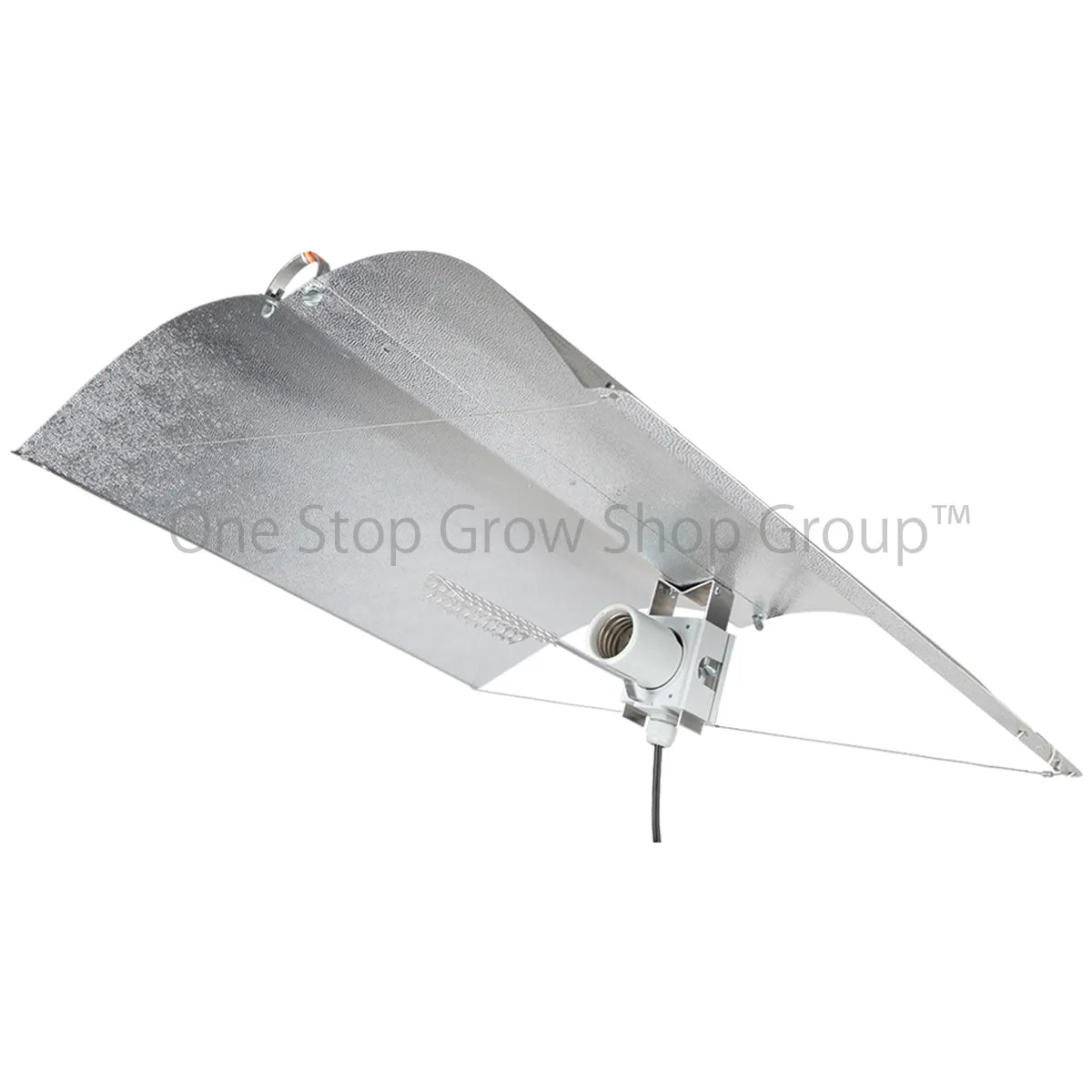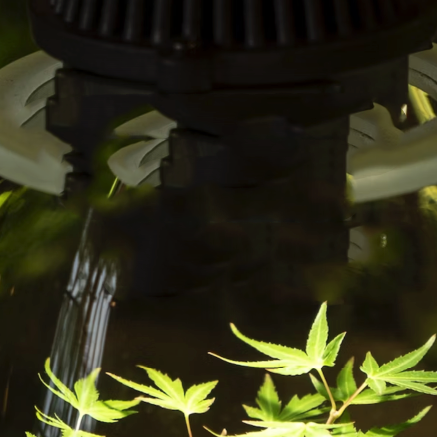Nearly all reflectors on the market are used "as is". In other words, you screw a lamp into it, hang it at the right height and that's it. There is no ability to alter its footprint or any other aspect of its performance other than by raising or lowering it above the canopy.
Why Change the Settings?
Let's imagine we are using a 600w HPS lamp as a light source. With certain wing and light height settings, the Adjust-A-Wings reflector can cast the light from this lamp far and wide to cover a large area.
With other settings, the Adjust-A-Wings reflector can concentrate that light over a much smaller area, which also increases the intensity and depth penetration.
The Adjust-A-Wings reflectors can be set up to produce both types of footprint - and many more in-between. However, although it might seem unusual, the Adjust-A-Wings' versatility really comes into its own when it is used to emulate the different seasons over a fixed area grow-space rather than to suit different size gardens.
So, When Should the Adjust-A-Wings be Adjusted?
Paul Cronk, the designer, has spent a long time studying this. His conclusion was this: out in nature, the temperature, the day-length, the intensity and the penetration of sunlight changes with the progression of the seasons. Plants have evolved over millions of years to respond to these changes in the day-length and the light intensity as the seasons change, and they use them as indicators of which growth phase they should be in.
Day-length, of course, is easily mimicked with the use of a contactor and a timer. However, the only reflector on the market that has been designed to emulate the seasonal changes in temperatures and light intensity is the Adjust-A-Wings. This is achieved by altering the combination of the wing-width, the lamp-holder height, and the hanging height of the reflector.
This holistic approach to grow lighting matches the intensity and penetration of light that plants have evolved to expect for the "season" (or growth phase) that they are in. It is no surprise, then, that it leads to overall happier, healthier, and more productive plants: (All the following footprint charts are with a 600w HPS over a 1.2m square area)
During vegetative growth, plants are usually short. They benefit from a good spread of light of medium intensity. The reflector should be at a narrow setting with the lampholder in a low position. The reflector should be a good distance from the top of the canopy - around 75-90cm. This setting simulates the Spring-time.
Once in the generative phase (flowering/fruiting), plants will be taller. The reflector should be set up to cast a more intense light which can penetrate further down to produce fruits/flowers on the lower parts of the plant. This is achieved with a wide wing setting and a high lamp-holder height. The reflector assembly should be hung much closer - about 40-60cm away from the canopy. This simulates the more intense light of Summer-time.
When the plants enter the end of the flowering process, they drastically slow down the production of new fruit-sets and concentrate on maturing the ones that have already been formed. Slightly reduced light intensity is best for this as it tells the plant that summer is turning to Autumn and it time to finish the flowering/fruiting process off. A medium wing setting and lamp height achieves this. The height of the reflector should be about 60-75cm. The Autumn settings will encourage essential oil production without reducing the swelling or maturation of the fruit.
Design is Everything
The ability to simulate three different seasons with just one reflector shows the thought and creativity that has gone into this design. The rest of the design has also been thought about just as carefully. Heat from the lamp is convected quickly away at the open ends at the front and rear of the reflector.
All three versions are manufactured to the highest standards. Each Adjust-A-Wings reflector comprises of two wings that are matched to each other at the factory. All the tolerances are very tight and the build quality is second to none. With an Adjust-A-Wings you can rest assured that you are buying one of the best made reflectors available on the market.
The Different Models
The ability to simulate three different seasons with just one reflector shows the thought and creativity that has gone into this design. The rest of the design has also been thought about just as carefully. Heat from the lamp is convected quickly away at the open ends at the front and rear of the reflector.
All three versions are manufactured to the highest standards. Each Adjust-A-Wings reflector comprises of two wings that are matched to each other at the factory. All the tolerances are very tight and the build quality is second to none. With an Adjust-A-Wings you can rest assured that you are buying one of the best made reflectors available on the market.
At the entry level, the Enforcer brings the Adjust-A-Wings concept to the market in a very affordable form. The 86% reflective surfaces are great by any standards. The Enforcer is available in small, medium and large sizes.
The Defender version of the Adjust-A-Wings design is quite unlike the Enforcer and Avenger. The industrial strength Defender takes double-ended lamps, rather than single-ended. The Defender was the initial model of choice for the Adjust-A-Wings Hellion system - a 750w 400v HPS light kit which comes complete with a DE lamp and ballast. The Defender model has a 92% reflective "titanium white" heat resistant powder coat surface which produces a highly diffuse and even light footprint.
The Avenger is the top-of-the-range model and boasts a vapour coated glass, titanium dioxide and ceramic wing surface. This gives a reflectivity of 95-97% which is matched by only the very best reflectors on the market. The Avenger is available in medium and large sizes and comes with an SE lamp-holder. However, the Avenger model can also accommodate a DE lamp holder. This means that the Avenger can be used as an upgrade to the Defender in the DE Hellion System. This is excellent news for those who will be using a 750W 400V Hellion system in more of a hobby or small grow setup and only want the very best.
While Paul Cronk was developing the Avenger, he realised that the 15% increase in crop yields could not be accounted for alone by the 3% increase in reflectivity over the Defender version. Much head-scratching ensued!
Paul Cronk looked at the way the complete Avenger unit worked as a whole and also at the individual materials and processes that come together that contribute to its performance. The only part that introduced some uncertainty into the way it worked was the flexible glass coating on the wings. He realised that even this thin coating produced a small but possibly significant amount of prismatic effect.
Optical prisms are pyramid-shaped pieces of glass. When a ray of white light hits one side of a prism, it is split into its component colours and exits the other side of the prism with a rainbow effect. The reason why this happens is a little beyond the scope of this article but if you would like to find out more about this effect then try web-searching "refraction". Paul Cronk realised that this refractive effect must be occurring, to some extent, as the light passed through the glass coating on the surface of the wings.
The next part of his thought process was a bit of a leap of imagination. What if plants noticed that the streams of photons hitting their leaves could sense this splitting up of the different wavelengths of light?
Out in nature, when sunlight hits raindrops, the same splitting of the different component wavelengths of the sunlight also produce this prismatic effect. Could it be that plants would perceive this to mean that there is rain and therefore plenty of water around with which to transpire, and respond to this by opening their stomata go into 'go-grow' mode? Could it possibly be that plants are responding because they know that water is in abundance? Nobody knows as yet, but one thing is for sure - it is definitely an interesting speculation!
How to Assemble an Adjust-A-Wings Reflector
The main part of the reflector is comprised of two parabolic-shaped reflective panels. They lock together quickly and easily in the centre with key-holes on one panel and studs on the other:
Once the wings have been slotted together, reinforcement brackets are screwed on at each end which double up as hanging points. Easy-to-use thumb-wheel bolts are provided for this purpose. The wings should never be drawn together unless the brackets have been securely fitted:
A steel wire at each end of the reflector bring the sides of the reflector downwards and together to form the double parabolic shape. As the name of the reflector suggests, the width between the sides of the reflector can be adjusted to change the shape.
First of all the cable end with two ferrules is fitted on the side with one keyhole. The second ferrule is provided just to make gripping the cable easier:
Then the other end of the cable is fed through the first slot on the other side and then back through one of the other three slots. This provides the ability to choose between the three wing shapes:
The process is repeated with another cable at the other end of the reflector.
Next, the adjustable lamp holder is screwed into one end using the provided thumb-wheel bolts:
After that, it just a matter of setting the height of the lamp holder in the bracket, fitting the lamp and then hanging it above your plants:
An easy-to-fit heat / light spreader brings the user even more options and is particularly useful if your plants get tall and you can't raise the height of the reflector any more.
So with the Adjust-A-Wings, you can be assured that you will be buying one of the most technically advanced reflectors on the market. Once you've tried one, you'll never want to go back. It's that simple! Even the entry level Enforcer offers way more at its price-point than any of its competition. Moving up to the Avenger brings you increases in yields that bely the uprated specification.

